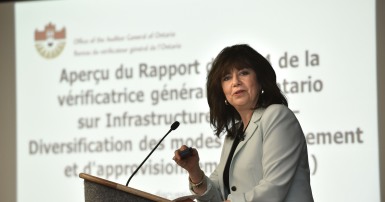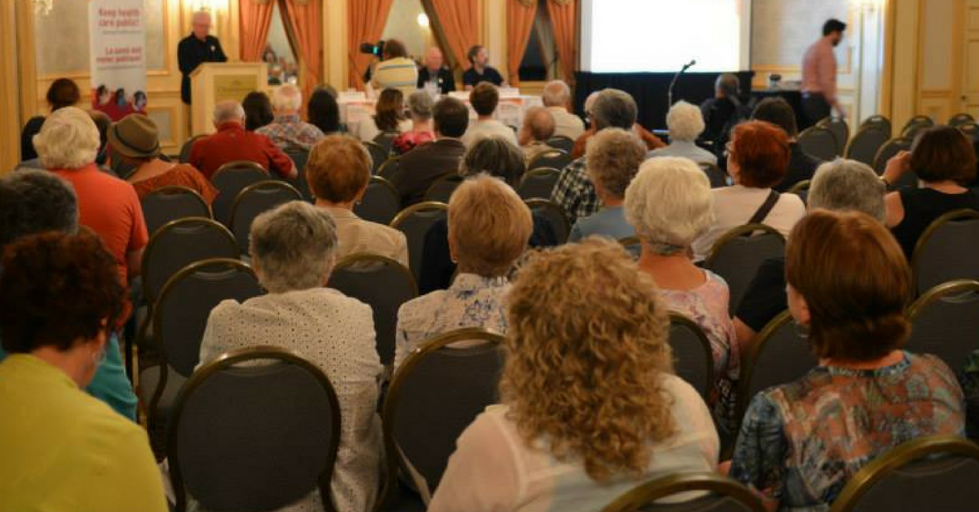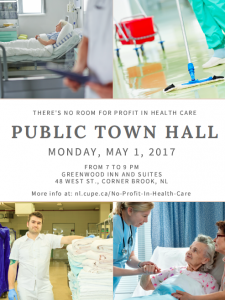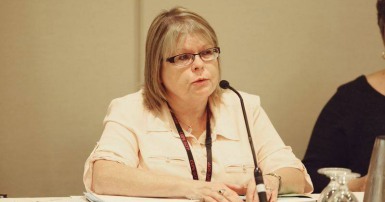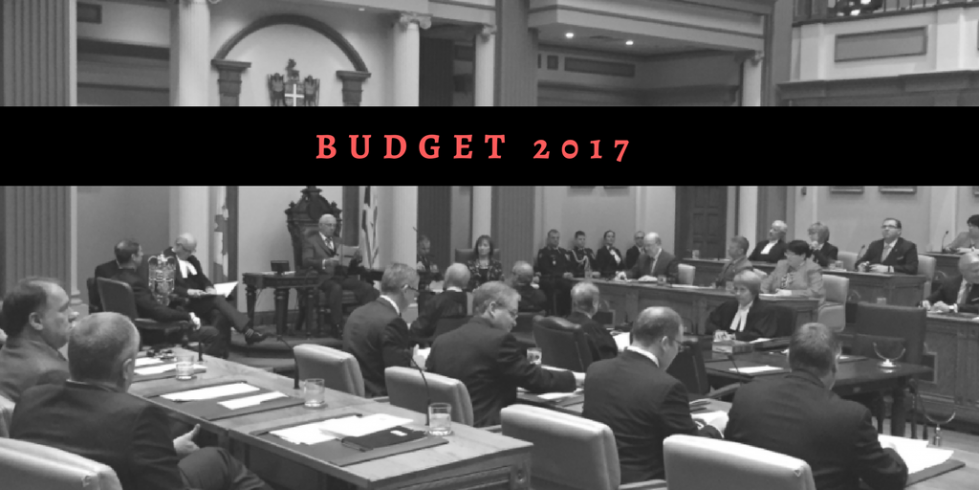In the Pre-Budget Discussion Guide, the Minister of Finance asks submissions to focus on aspects of the government’s economic plan outlined in The Way Forward.
CUPE Newfoundland Labrador, along with the Common Front NL, has communicated strong opposition to the economic direction government is currently pursuing.
CUPE has made clear in meetings with the Minister of Finance and in various briefs and submissions that a recession is not the time to be focused on balancing the budget and cutting jobs. Government has options to raise revenues to both address the deficit in a reasonable timeframe and invest to stimulate economic growth in the short term. To reiterate, public services deliver terrific value to families and communities as well as stimulus to local economies.
Furthermore, CUPE Newfoundland Labrador urges the Minister of Finance to change policy direction on two important public services: the slated closures of provincial public libraries and use of the P3 model for the acute care hospital and long term care facility in Corner Brook.
PROVINCIAL PUBLIC LIBRARIES
The proposed closing of 54 of the province’s 95 libraries (57%) represents a serious loss of value to the communities affected and to the economy of Newfoundland Labrador. If these closures go ahead, more than 60 members of CUPE Local 2329 will lose their jobs. The majority of those who will find themselves out of work are women who work part-time in rural communities.
CUPE is disappointed that neither the Minister of Education and Early Childhood Development Dale Kirby nor the Provincial Information and Library Resources Board (PILRB) have responded to CUPE’s requests to meet on this issue.
CUPE is calling on the Minister of Education and Early Childhood Development to release the report from the financial and consulting accountancy firm EY who were contracted to review the library system and hold public consultations. The EY report should be released prior to the tabling of the provincial budget this spring.
Funding for provincial libraries have already been significantly reduced over the last few years and this has had profound impacts on library services in the province. Insufficient capital and materials budgets have affected the acquisition of new publications and the maintenance and/or replacement of existing equipment. Technical support for the entire system has been slashed, with a staff of eight – already a skeleton crew when it comes to serving 95 locations – cut down to five, making it even harder to meet demand. Over seventeen full-time equivalent staff positions have been eliminated, and the budget for substitute staff has been cut. Now 77 libraries in the system operate with only one staff person. One library in the system has already been forced to close.
Despite operating with limited resources, public libraries in Newfoundland Labrador are highly utilized. In 2014-2015, the public library in Harbour Grace – slated to close under the PILRB proposal – reported a circulation rate of 169% relative to its population (including online circulation and inter-library loans).
The library in Centreville – also slated to close – recorded a per-capita circulation rate of 420%. Internet services are equally compelling.
Brigus, a small community of 794, reported 3539 computer and Wi- Fi sessions in 2014-2015 and 2710 sessions in 2015-2016, a per-capita rate of 446% and 341%, respectively.
There is no indication that the “regional library model” will be able to supplement, improve, or replace the current system’s ability to meet both circulation and information service demands.
The important role of public libraries is clearly evident in Newfoundland Labrador. The province’s own data indicates a heavy reliance on the library system for computer access and Wi-Fi access. Event calendars show a wide variety of programming. For example, the following programs are currently being offered at libraries that are slated for closure (despite being already under-resourced):
- Cow Head Public Library – The Art of Darning (skill), Preschool Reading Circle (literacy)
- Stephenville Crossing Public Library – Babysitting Course (skill, childcare), Halloween Storytime (literacy)
- Fogo Island Public Library – Burlap Wreath Making (craft), Coffee and Canvas (art)
- Change Islands Public Library – Library Home Services (book delivery to seniors, social support)
- Bay St. George South Public Library – Computer Training (skill), Story Time (literacy)
- Harry’s Harbour Public Library – Craft Night (craft)
- Norris Arm Public Library – Computer Training (skill), Talking Books (literacy), Story Time (literacy)
Beyond programming, Newfoundland Labrador libraries support community cultural programs, such as the Writers at Woody Point Festival, and provide links to community heritage, such as in Trepassy and other communities on the Irish Loop.
The PILRB has offered no satisfactory plan for how these important services and linkages will be maintained. While the proposed cuts may save a marginal sum of money, the loss of the “connecting layer of society” in many of these communities is not worth the savings. But even if this important role is discounted and libraries are evaluated in narrow economic terms, they show themselves a smart and highly productive investment, as explained below.
In the current political and economic climate, public libraries must often seek to justify their existence to policy-makers, communities, and stakeholders. Given the range of services that libraries provide, and the roles that they can play in communities and for their patrons, it can be difficult to quantify the value that libraries represent in simple dollar figures.
Like other educational institutions, libraries offer intangible value that is experiential, often expressed via concepts such as learning, knowledge, experience, and practice. Like other social institutions that provide intangible value, libraries are often among the first public institutions to face the consequences of an economic crunch. It is no longer sufficient, therefore, to presume a consensus on a public library’s value as a public good. Rather, library value is often “seen through the lens of a business model,” where patrons are clients who seek a return on investment.
CUPE recommends that the provincial government reverse the decision to close 54 of the province’s 95 public libraries, and restore funding at least to 2011 levels.
Even using this metric, public libraries are excellent investments that produce measurable economic value multiple times the level of funding they receive from the government. This value in seen many ways, including local economic development, increased property values, and the generation of social capital.
As noted in previous CUPE submissions to the provincial government, the Martin Prosperity Institute at the University of Toronto released a report in 2013 that measured the economic impact of Toronto’s 98 public libraries.The report’s findings included:
- For every dollar invested in the libraries, Torontonians received $5.63 of return value.
- On average, each hour that any of the branches were open cost the city $653 but generated $2515 in measurable economic benefit.
- For library patrons, the value of a (free) library membership was $500 on average per year.
Results of a similar study in Guelph, Ontario, reveal equally compelling data.Using a similar methodology to the Martin Prosperity Institute report in Toronto, the Guelph Public Library calculates its return on investment as $5.33 for every dollar of public investment. The value of a library membership for users was calculated at $673 yearly.
Nearby in London, Ontario, the return value of the London Public Library has been measured at 452%, and it is estimated to generate $102 million in total economic impact on the city. For every dollar invested in the public library, Londoners receive $6.68 in value.There is possibly no other public institution with greater direct and indirect positive economic impact than the public library.
These findings in Canada echo others from around the world.
United Kingdom
A 2002 study out of Loughborough University found that the public library system in the UK generates 12.6% more value than it costs. This is before taking into account “the intangible benefits provided through its public service and merit features.” The study concludes that the value of the public library is considerable in terms of economic value and in terms of serving as a public good and an institution of social development and cohesion.
United States
A study of the public library system in Minnesota undertaken in 2011 found that the library has a $4.62 return on investment for every $1 of public tax support it receives. The report also notes that the public library generates secondary value that is not captured in the return on investment metric:
Proximity to the library has value. Users who stop at the library while completing a longer list of errands report “halo” spending at firms and establishments close to the library. Although this spending is not part of an economic impact statement of Minnesota’s public libraries, it is also true that proximity to a library increases spending for those businesses located near the library.
A similar study out of Wisconsin found that the public library produces a return on investment of $4.06 for every dollar of taxpayer investment. The report outlines four ways in which this return is achieved:
- Jobs generated by non-payroll library expenditures (such as acquisitions)
- Service employment resulting from direct and indirect library expenditures
The same study noted that beyond the monetary value, public libraries generated positive measurable quality of life impacts, and that the “free access to information and technology” served to “level the playing field for many low-income people.”
Norway
According to a study of the national library system in Norway, “the value of the Norwegian public libraries decidedly outweighs their costs.” Similar to Newfoundland and Labrador, a high proportion (56%) of Norway’s public libraries are in rural communities with populations less than 5,000. Results of the study show that residents stressed the importance of libraries to local democracy and civic engagement. The report measured a four-fold return on investment (i.e. four NOK return for every one NOK of public money invested).
Approximately 90% of study participants also believed that reallocating library funding to other municipal services was undesirable, even if those other municipal services also were a benefit to their household. The researchers conclude that “using resources on public libraries is worth more in terms of individuals’ welfare than alternative use of resources.”
South Korea
A recent study in South Korea reviewed the national library system and measured the value produced relative to all public spending, including salaries and benefits, materials purchasing, and operating costs. Return on investment was measured at 366% – 3.66 units return for every one unit of input.
The Korea study also found in its review of the literature that the necessity of justifying the expense of public libraries was increasing in many disparate jurisdictions, and that in all cases the return on investment was positive and significant. A return on investment of 3.66 was consistent with a wide range of other studies using a diverse array of methodologies.
Ironically, it is during times of economic constraint that many library budgets are cut, in a short-sighted attempt to contain extraneous costs. This is counterproductive. A well-funded, robust library system produces value and provides services to patrons that cannot be easily replaced. The public library responds to local needs and can adapt services to meet the demands of patrons.
Library staff know their communities, and are trained to facilitate appropriate and effective service delivery. Public libraries are a wise investment from both an economic and public good perspective.
The contribution of public libraries to the public good is not static.
The more plentiful and stable public library funding is, the more people it can help; the greater number of services, resources, and materials it can provide; the more community partnerships it can create; and the bigger impact it can have on its community. The size of the public good generated by the public library grows with the amount of support given to the library.
Due to their resources and the skills of staff members, public libraries can become centers for social services, emergency response and recovery, e-government, digital literacy and inclusion, job training, and innumerable other contributions to the health of the community, so long as they are provided sufficient support.
The public library is, in short, a public good that can adapt and expand through proportional increases in funding.
CUPE is calling on the Minister of Education and Early Childhood Development to release the report from the financial and consulting accountancy firm EY who were contracted to review the library system and hold public consultations. The EY report should be released prior to the tabling of the provincial budget this spring.
CUPE recommends that the provincial government reverse the decision to close 54 of the province’s 95 public libraries, and restore funding at least to 2011 levels.
CORNER BROOK ACUTE CARE HOSPITAL AND LONG TERM CARE FACILITY
CUPE is dismayed by the Premier’s announcements that the much-needed Long Term Care facility and acute care hospital in Corner Brook will be built as public-private partnerships (P3s).
Auditor Generals, researchers and journalists across Canada have documented the problems with P3s also known as Alternative Funding Procurements (AFPs). The list of P3 failures and their unnecessary waste of taxpayers’ money grows, yet here we are in Newfoundland Labrador about to embrace that discredited model.
Below is a short and incomplete list of just five of the Canadian P3 health care facilities that went wrong. They are a warning about why we should not put our health care dollars into the pockets of private companies – companies who may not even be from our province.
CUPE recommends that the provincial government build the acute care hospital and the Long-Term Care Facility in Corner Brook using the traditional public procurement process.
North Bay Regional Hospital – Ontario
The P3 North Bay Regional Hospital cost at least $160 million more as a P3. The project financing costs are adding millions extra each year, over 50 beds have been closed, and they are on the third round of layoffs with over 100 jobs cut. The hospital has only been open since 2011.
Royal Ottawa Mental Health Centre – Ontario
The Royal Ottawa Hospital mental health facility opened in November 2006 – smaller than originally planned, and with fewer beds. The final cost of the P3 hospital was $146 million, a cost overrun of $46 million. Economist Hugh Mackenzie analyzed publicly available financial details of the ROH. He concluded that private financing added $88 million to the hospital’s costs.
Montréal’s University Health Centres
In 2014, the Quebec newspaper La Pressereported that Auditor General Renaud Lachance released a review of Montréal’s University Health Centres explaining that the capital cost estimates were at least $1.8 billion over the original $5.2 billion announced for the P3 project.
William Osler Hospital – Ontario
The William Osler Health Centre in Brampton, Ontario is another example of a P3 gone wrong. In 2008, the Ontario Auditor General found that the building of the P3 facility cost $194 million more (in 2003 dollars) than it would have as a public hospital.20 Local fundraising in Brampton had to increase to more than $230 million from an original $100 million in order to try to cover the difference. In the words of Globe and Mail columnist Andre Picard, “taxpayers got screwed”.
Diamond Health Care Centre, Vancouver General Hospital – British Columbia
In the case of the P3 Diamond Health Care Centre, the actual nominal cost of a P3 was more than double that of a publicly procured project. In 2009, forensic accountants found that the Diamond Centre in Vancouver’s General Hospital total nominal cost (whole life cost including maintenance) could have been $89 million if it was built publicly. The BC provincial government spent $203 million – or $114 million more – on the hospital as a P3.
Public funding of infrastructure is well known to be the least expensive way to finance major infrastructure projects.
Public-private partnerships tap private investors to finance, design and maintain infrastructure projects. Private investors naturally demand rates of returns that need a profitable revenue stream—which taxpayers pay for through guaranteed annual payments from government.
There’s plenty to be wary of in P3s—higher costs, loss of transparency and accountability of public assets. Keep our long-term care facilities public.
CUPE recommends that the provincial government build the acute care hospital and the Long-Term Care Facility in Corner Brook using the traditional public procurement process.
 Ontario
Ontario

